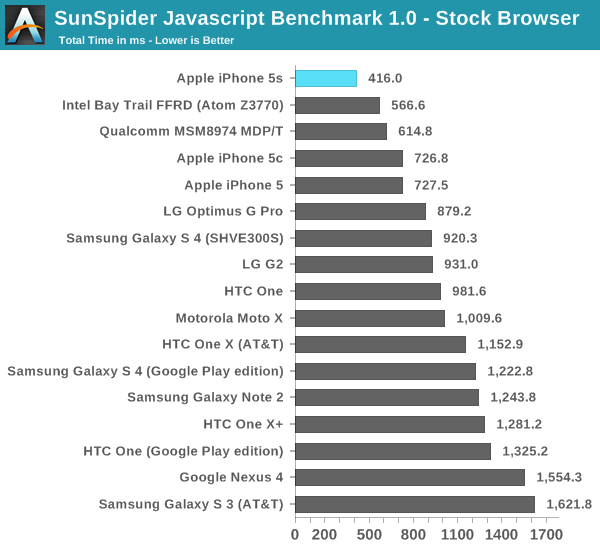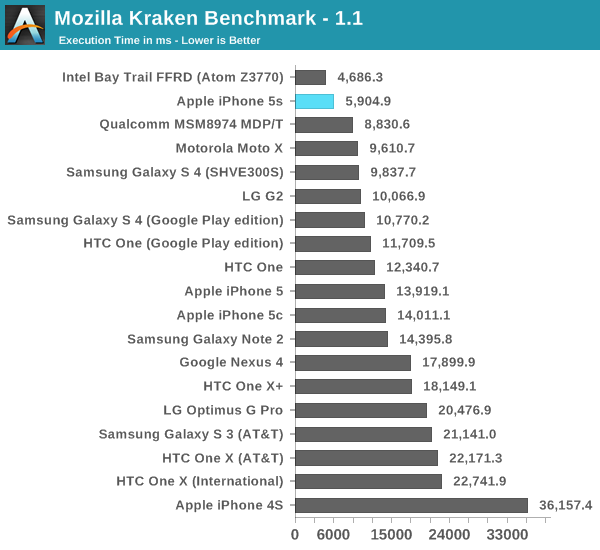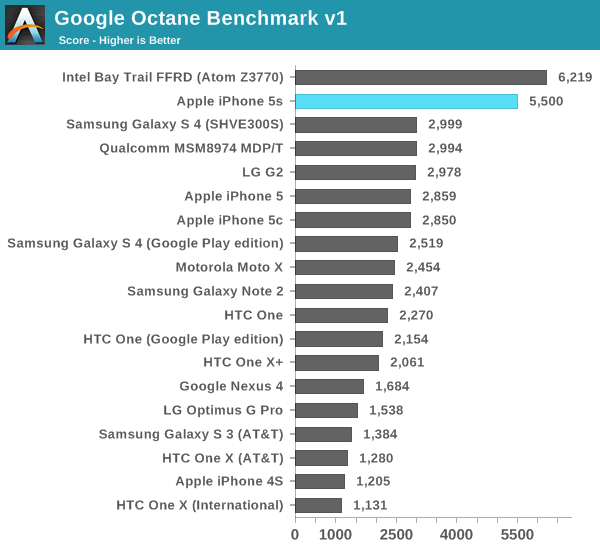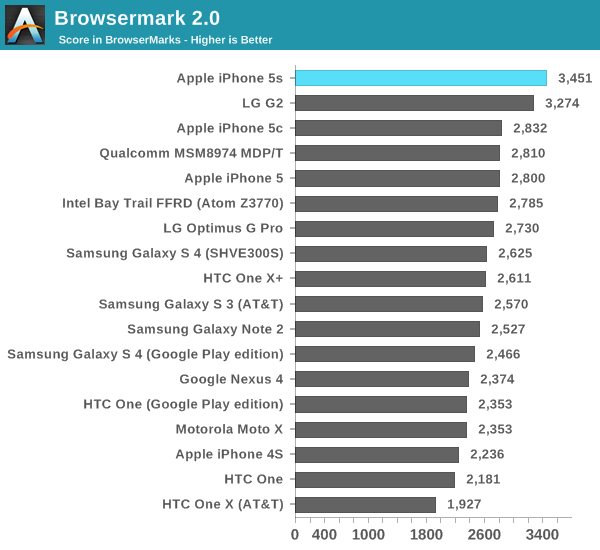The iPhone 5s Review
by Anand Lal Shimpi on September 17, 2013 9:01 PM EST- Posted in
- Smartphones
- Apple
- Mobile
- iPhone
- iPhone 5S
CPU Performance
For our cross-platform CPU performance tests we turn to the usual collection of Javascript and HTML5 based browser tests. Most of our comparison targets here are smartphones with two exceptions: Intel's Bay Trail FFRD and Qualcomm's MSM8974 Snapdragon 800 MDP/T. Both of those platforms are test tablets, leveraging higher TDP silicon in a tablet form factor. The gap between the TDP of Apple's A7 and those two SoCs isn't huge, but there is a gap. I only include those platforms as a reference point. As you're about to see, the work that Apple has put into the A7 makes the iPhone 5s performance competitive with both. In many cases the A7 delivers better performance than one or both of them. A truly competitive A7 here also gives an early indication of the baseline to expect from the next-generation iPad.
We start with SunSpider's latest iteration, measuring the performance of the browser's js engine as well as the underlying hardware. It's possible to get good performance gains by exploiting advantages in both hardware and software here. As of late SunSpider has turned into a bit of a serious optimization target for all browser and hardware vendors, but it can be a good measure of an improving memory subsystem assuming the software doesn't get in the way of the hardware.

Bay Trail's performance crown lasted all of a week, and even less than that if you count when we actually ran this benchmark. The dual-core A7 is now the fastest SoC we've tested under SunSpider, even outpacing Qualcomm's Snapdragon 800 and ARM's Cortex A15. Apple doesn't quite hit the 2x increase in CPU performance here, but it's very close at a 75% perf increase compared to the iPhone 5. Update: Intel responded with a Bay Trail run under IE11, which comes in at 329.6 ms.
Next up is Kraken, a heavier js benchmark designed to stress more forward looking algorithms. Once again we run the risk of the benchmark becoming an optimization target, but in the case of Kraken I haven't seen too much attention paid to it. I hope it continues to fly under the radar as I've liked it as a benchmark thus far.

The A7 falls second only to Intel's Atom Z3770. Although I haven't yet published these results, the 5s performs very similarly to an Atom Z3740 - a more modestly clocked Bay Trail SKU from Intel. Given the relatively low CPU frequency I'm not at all surprised that the A7 can't compete with the fastest Bay Trail but instead is better matched for a middle of the road SKU. Either way, A7's performance here is downright amazing. Once again there's a performance advantage over Snapdragon 800 and Cortex A15, both running at much higher peak frequencies (and likely higher power levels too, although that's speculation until we can tear down an S800 platform and a 5s to compare).
Compared to the iPhone 5, the 5s shows up at over 2.3x the speed of last year's flagship.
Next up is Google's Octane benchmark, yet another js test but this time really used as a design target for Google's own V8 js engine. Devices that can run Chrome tend to do the best here, potentially putting the 5s at a disadvantage.

Bay Trail takes the lead here once again, but again I expect the Z3740 to be a closer match for the A7 in the 5s at least (it remains to be seen how high the iPad 5 version of Cyclone will be clocked). The performance advantage over the iPhone 5 is a staggering 92%, and obviously there are big gains over all of the competing ARM based CPU architectures. Apple is benefitting slightly from Mobile Safari being a 64-bit binary, however I don't know if it's actually getting any benefit other than access to increased register space.
Our final browser test is arguably the most interesting. Rather than focusing on js code snippets, Browsermark 2.0 attempts to be a more holistic browser benchmark. The result is much less peaky performance and a better view at the sort of moderate gains you'd see in actual usage.

There's a fair amount of clustering around 2500 with very little differentiation between a lot of the devices. The unique standouts are the Snapdragon 800 based G2 from LG, and of course the iPhone 5s. Here we see the most modest example of the A7's performance superiority at roughly 25% better than the iPhone 5. Not to understate the performance of the iPhone 5s, but depending on workload you'll see a wide range of performance improvements.










464 Comments
View All Comments
flyingpants1 - Wednesday, September 18, 2013 - link
Sorry, no. As much as I hate Apple products.. Apple is killing it with amazing battery life, some of the best IPC, possibly best thermals (and therefore lowest profile) and the BEST performance, all at the same time.Whatever you said about testing multiple phones doesn't matter. It doesn't change facts.
melgross - Wednesday, September 18, 2013 - link
The Moto X hardly competes at all. What he said is true. We're talking an SoC that runs at a lower speed, often considerably slower. What Apple comes out with new iPads in October, they will increase clock speed by 15% or so, and often with more GPU cores as well, usually by 50%. We'll see what the chip can really do then. To be compared to tablets, and come ahead is pretty damning to other processor manufacturers.jeffkibuule - Wednesday, September 18, 2013 - link
When you design both hardware and software, you get optimize far more that when an OEM gets code from Google and *attempts* to get it working best on their hardware. And lets be clear, Android OEMs are clearly throwing more hardware at a software problem, when even a Windows phone with a 1.5 year old SoC in the Lumia 1020 feels far smoother and fluid that the latest Android phone.ananduser - Wednesday, September 18, 2013 - link
Simple...in the current smartphone game of leapfrog, the last one to release its flagship is the top dog. This time the A7 sports a brand new, benchmark "friendly", ARM designed ISA. Next time Exynos will have the upper hand, or Qualcomm, or nVidia.The GPU is made by Imagination not by Apple. The other manufacturers are trying to push their own solution rather than making due with a 3rd party. Technically any other manufacturer could pay Imagination for their Rogue chipset.
Good for you, really.
akdj - Wednesday, October 9, 2013 - link
"This time the A7 sports a brand new, benchmark "friendly", ARM designed ISA. Next time Exynos will have the upper hand, or Qualcomm, or nVidia."You're right---of course, as technology progresses----but the funny thing is, even the 'year old' iPhone 5 holds it's own against even the latest flagship Android devices when it comes down to graphics and browsing/energy (battery life). Apple's NOT just buying off the shelf parts from Imagination----they've hired many a chip expert/designer in house and are now not only optimizing their S/W code to the chip---they're also designing the chips architecture to their system with Imagination and in house skill sets. No other company is doing this yet...and with the new A8 instruction set---this is the best I've seen in 's' updates since the release of the 3GS.
It's a strong move by Apple, these past few years---to apply their own instruction and low level programming as well as SoC design, match up to iOS...the software integrate(ability) with the hardware....and perhaps most importantly, their relationship with carriers (good or terrible, it's irrelevant) as they're huge sellers and contract 'getters' --- and the inability for the carriers to add their own skin has been brilliant. That, to me...and IMHO was one of the great 'feats' Steve Jobs pulled off. Obviously it only initially worked with AT&T----but Verizon almost immediately was beggin to get on board and now they've not only managed to penetrate small mom n pop services in the US---but open themselves up in China, India and Japan to some of the largest carriers (and population served) in the world.
To me, this IS the route Google should take---and reign in both the OEMs and the carriers, but why would they care? They're not hardware makers (for profit anyways)---they're miners, advertiser first aid kits----Data Miners. Your Information is their Money. Period.
Regardless of who makes the SoC, as long as their continues to be bloated Java skins on top of Android, the 'experience' with Apple will be 'better' when it comes to fluency, updates, app selection and app development (Money Paid to developers), et al.
J
Miserphillips - Tuesday, September 17, 2013 - link
iOS 7 very heavily copied Windows Phone.melgross - Wednesday, September 18, 2013 - link
It's nothing at all like that laggard—thankfully.nephipower - Tuesday, September 17, 2013 - link
Can you share how much more space is used on the device because the native apps are now 64 bit?solipsism - Tuesday, September 17, 2013 - link
Like all additional binaries it's negligible. The times you'll notice extra space being used is when you need additional resources, like images for 1x and 2x display (i.e.: Retina) or making a Universal app that needs to support both iPhone and iPad UIs.tech01x - Wednesday, September 18, 2013 - link
Actually, no extra space for images. It's the pointers that are double in size, so depending on the application, there will be additional RAM usage.